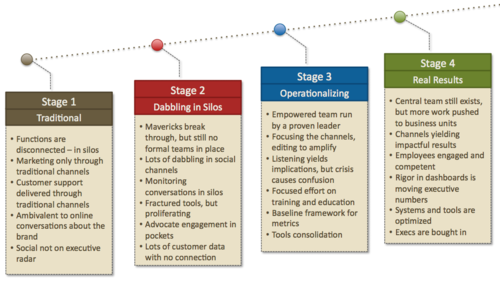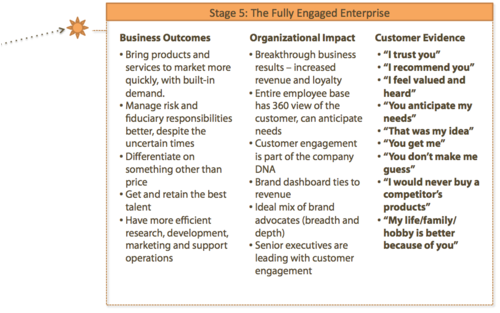Nowadays most brands realize that they have to actively engage with customers and build up their social media presence in order to be successful. What often gets overlooked is an honest assessment of where they are on that engagement journey.
Ant’s Eye View is a social media consulting firm that has done a great job of mapping out the stages companies typically go through on their social media engagement journey. As they explain it, this journey is the process of transforming the customer experience and brand engagement strategy by activating and embedding customer voice in every aspect of your business.
Check out the chart below and think about where your brand falls.


The question we like to ask our employees is "where would you place salesforce.com on this path?" How about your department, our competitors, and our average customer? And where should we be? This often sparks great discussions.
If I were to plot where salesforce.com is today, I’d put us at a stage 4. Here is the thought process behind that grade.

Central team still exists, but more work pushed to business units
Social channels are yielding impactful results
- Case deflection on the online community is the easiest way to measure ROI. If you have a question answered on an online forum and that question is seen by 200 unique visitors a month, you might estimate that some % of those visitors (call it 20%) didn’t need to log a case. In this case your cost savings is 40 people x cost per call center case (maybe $40).
- YouTube is one of the key influencers on buying decisions & we’ve got the story of the hyper-efficient sales rep to highlight how much work is being lifted from your customer facing employees.
- Facebook & Twitter are allowing us to amplify our messages. While it is harder to track this back to ROI, we look at it similarly to lead nurturing at the top of the marketing funnel.
Employee engaged and competent
Rigor in dashboards is moving executive numbers
- We have social media dashboards in the “62 org” so we can raise visibility around what are our goal, what teams are leading the way, and who is lagging.
- There are TV monitors set up on our marketing floor looping our social metric leaderboards and explaining why these metrics are important.
- Our social metrics are included in our barometer reports alongside our other key marketing metrics like website visitors and pipeline.
- There are initiatives underway to pull more of our social data into our marketing automation systems to help influence lead scoring and campaign attribution.
Systems and tools are optimized
- Our Social Media Command Center is almost a year old now (pictured above) and it is highly tuned. We’ve documented our processes and engagement best practices.
- This year we’re making big investments into our Social CMS. This is the platform that we use to manage our content calendar, access to social channels, page builder, social advertising, and social analytics.
Execs are bought in
- At salesforce.com we are fortunate to have a CEO like Marc who believes in social and is pushing us to adopt new paradigms. When you’ve got buy-in from the top that permeates throughout the company.
Stage 5 on their scale is an aspirational stage but one we are driving hard towards. We want to get to the point where every customer says, “I trust you, I recommend you, I feel valued, I am product to be part of the salesforce.com community.”
Back to the question we presented earlier.
- Where would you place your company on this path?
- How about your department, competitors, or average customer?
- And where should you be?

